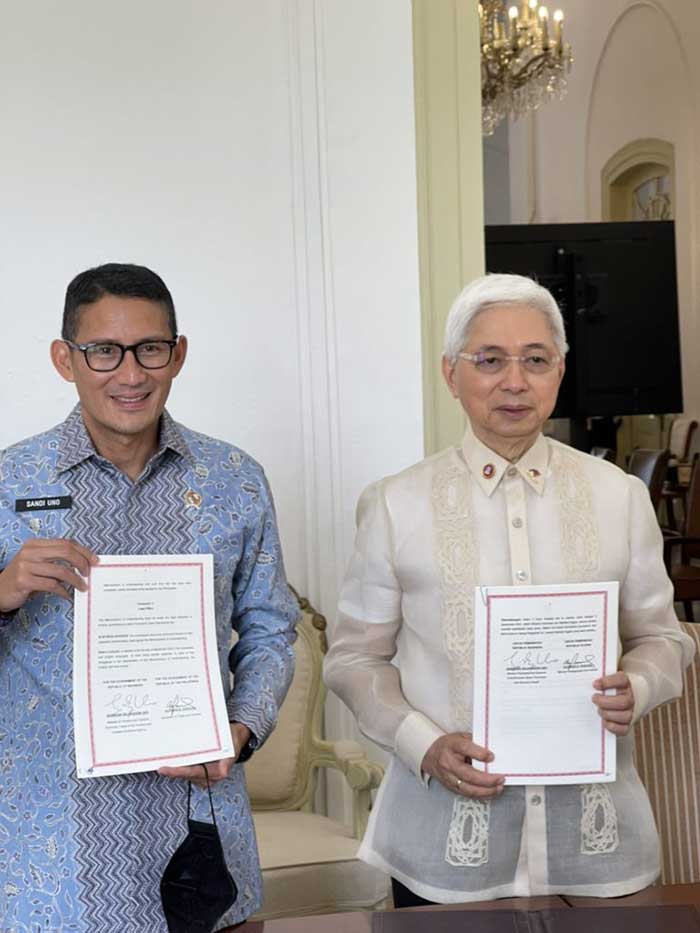
Jakarta, Indonesia—The Philippines’ creative community will soon have an additional potential audience of about 280 million Indonesians as the two countries signed a Memorandum of Understanding (MOU) for Cooperation in the Development and Promotion of the Creative Economy between the Philippines and Indonesia.
Philippines’ Department of Trade and Industry (DTI) Secretary Alfredo Pascual and Indonesian Minister of Tourism and Creative Economy Sandiaga Uno on Monday, September 5 signed the MOU that among others, agree on the exchange of information on market research and policy trends, as well as facilitate co-production, co-branding programs, and marketing of creative products, goods and services.
“With the signing of this MOU, we look forward to closer cooperation with Indonesia in the development of our two countries’ creative economies,” Secretary Pascual said.
He added, “This agreement is also in line with our government’s goal of elevating the Philippine creative economy and increasing its competitiveness globally.”
The MOU identified the creatives community to include fashion, interior, landscape, jewelry, and architectural designers; culinary artists; filmmakers; television and radio content creators; internet podcasters; game developers; animators; musicians; theatre artists; dancers; authors; and illustrators.
According to the Creative Economy Council of the Philippines (CECP), about 2 to 3 million Filipino creative freelancers work locally, while 1.5 million Filipino creatives handle international projects.
Assistant Secretary Glenn Peñaranda, Officer-in-Charge for DTI’s Trade Promotions Group (TPG), said that while the Philippines is the top exporter of creative services in the ASEAN region, the country’s total creative exports only amount to 2% of the market share in Asia-Pacific.
Secretary Pascual said, “This situation presents both ample room for growth and an opportunity for the Philippines to invest especially in creative goods and services.”
Earlier, in a speech at the Creative Futures 2022 in Manila, Secretary Pascual emphasized DTI’s goal of elevating the Philippine creative economy and increasing its competitiveness globally.
“Creativity is in the Filipino DNA, quietly feeding humanity’s soul and the Philippine economy. Whether we create or experience them, the creative industry improves our quality of life,” stressed the trade chief.
DTI has been implementing the Creative Economy Strategy of the Philippines, (CREST PH), which addresses the challenges of the new normal. CREST PH seeks to build a supportive environment for the creative industries to promote integrated industry development for the sector.
“We can work together to build a vibrant, scaled-up Philippine creative economy at the forefront of the Asia-Pacific Region, driving our country’s development and enriching our culture,” Secretary Pascual underscored.
MOU signatories shall establish a Joint Working Group called Philippines-Indonesia Joint Task Force that would facilitate and evaluate its implementation.
Also, the Philippines is set to participate in the World Conference on Creative Economy 2022 in Bali, Indonesia this October 2022.
According to UNCTAD Creative Industry 4.0, the value of global creative goods exports was $548 billion in 2019, prior to the COVID-19 pandemic. This amount was equivalent to about 3% of the total value of global merchandise exports for the year. Likewise, the preliminary estimates, global trade in creative services was around US$1 trillion in 2019, accounting for 18% of total trade in commercial services.




















